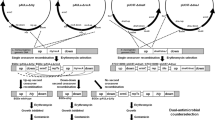Abstract
A rapid, simple, and effective method for the curing of a wide range ofEscherichia coli antibiotic resistance plasmids is described. Treatment with acridine orange followed by growth in sublethal concentration of antibiotics and penicillin selection under such bacteriostatic conditions resulted in a curing efficiency of more than 98% in all cases tested. The method is equally applicable, with modifications, to other enteric bacteria such asKlebsiella pneumoniae. It is also equally applicable to nutritional markers for which toxic analogues exist, and to elimination of recombinant bacteriophages containing antibiotic resistance transposons.
Similar content being viewed by others
Literature Cited
Baron, L. S., Kopecko, D. J., McCowen, S. M., Snellings, N. J., Johnson, E. M., Reid, W. C., Life, C. A. 1982. Genetic and molecular studies of the regulation of atypical citrate utilization and variableVi antigen expression in enteric bacteria, pp. 175–194. In: Hollander, A. (ed.), Genetic engineering of microorganisms for chemicals. New York: Plenum.
Bouanchand, D. H., Scavizzini, M. R., Chabert, Y. A. 1969. Elimination by ethidium bromide of antibiotic resistance in enterobacteria and staphylococci. Journal of General Microbiology54:417–425.
Bradley, D. E., Hughes, V. M., Richards, H. 1982. R-plasmids of a new incompatibility group determine constitutive production of H-pili. Plasmid7:230–238.
Bukhari, A. I., Shapiro, J. A., Adhya, S. L. 1977. DNA insertion elements, plasmids and episomes. Cold Spring Harbor, NY: Cold Spring Harbor Laboratory.
Gellert, M., O'Dea, M. H., Tomizawa, J. 1979. Novobiocin and coumermycin inhibit DNA supercoiling catalyzed by DNA gyrase. Proceedings of the National Academy of Sciences USA73:4474–4478.
Hahn, F. E. 1976. Experimental elimination of R factors, pp. 196–220.In:Grenzach, H. S., Brockman, R. W., Hahn, F. E. (eds.), Antibiotics and chemotherapy. Basel: S. Karger.
Hirota, Y. 1960. The effect of acridine dyes on mating type factors inEscherichia coli. Proceedings of the National Academy of Sciences USA46:57–64.
Johnston, J. H., Richmond, M. H. 1970. The increased rate of loss of penicillinase plasmids fromStaphylococcus aureus in the presence of rifampicin. Journal of General Microbiology60:137–139.
Kado, C. I., Liu, S. T. 1981. Rapid procedure for detection and isolation of large and small plasmids. Journal of Bacteriology145:1365–1373.
Kondo, E., Mitsuhashi, S. 1964. IV. Active transducing bacteriophage P1 CM produced by a combination of R factor with bacteriophage P1 drug resistance of enteric bacteria. Journal of Bacteriology88:1266–1276.
Macrina, F. L., Balbinder, E. 1972. Genetic characterization of a stable F′lac plasmid. Journal of Bacteriology112:503–512.
McHuch, G. L., Swartz, M. N. 1977. Elimination of plasmids from several bacterial species by novobiocin. Antibiotics and Chemotherapy12:423–426.
Novick, R. P. 1969. Extrachromosomal inheritance in bacteria. Bacteriological Reviews33:210–263.
Pares, R., Guinea, J., Hernandez, S., Valoix, J., Jofre, J. 1974. A new episomic element controlling fermentative metabolism and excretion of amino acids byC. intermedius C3. Journal of Bacteriology119:9–18.
Penney, R. J., Smith, J. T. 1971. R-factor elimination by thymine starvation. Genetical Research18:173–177.
Riva, S., Fietta, A., Berti, M., Silvestri, L. G., Romero, E. 1973. Relationships between curing of the F episome by rifampin and by acridine orange inEscherichia coli. Antimicrobial Agents and Chemotherapy3:456–462.
Somers, J. M., Sweet, G. D., Kay, W. W. 1981. Fluorocitrate resistant tricarboxylate transport mutants ofSalmonella typhimurium. Molecular and General Genetics181:338–345.
Taylor, D. E., Sommers, A. O. 1979. Association of tellurium resistance and bacteriophage inhibition conferred by R-plasmids. Journal of Bacteriology137:1430–1433.
Tomoeda, M., Inuzuka, M., Kubo, N., Nakamura, S. 1968. Effective elimination of drug resistance and sex factors inEscherichia coli by sodium dodecyl sulfate. Journal of Bacteriology95:1078–1089.
Watanabe, T., Fukasawa, T. 1961. Episome-mediated transfer of drug resistance inEnterobacteriaceae. II. Elimination of resistance factors with acridine dyes. Journal of Bacteriology81:679–683.
Williams-Smith, H., Parsell, Z., Green, P. 1978. Thermosensitive H1 plasmids determining citrate utilization. Journal of General Microbiology109:37–47.
Zimmerman, W., Rosselet, A., Knüsel, F. 1971. Effect of rifampicin and selected rifamycin derivatives on staphylococcal β-lactamase plasmids. Annals of the New York Academy of Science182:329–341.
Author information
Authors and Affiliations
Rights and permissions
About this article
Cite this article
Tomás, J.M., Kay, W.W. A simple and rapid method for the elimination of R plasmids from enteric bacteria. Current Microbiology 11, 155–157 (1984). https://doi.org/10.1007/BF01567341
Issue Date:
DOI: https://doi.org/10.1007/BF01567341




